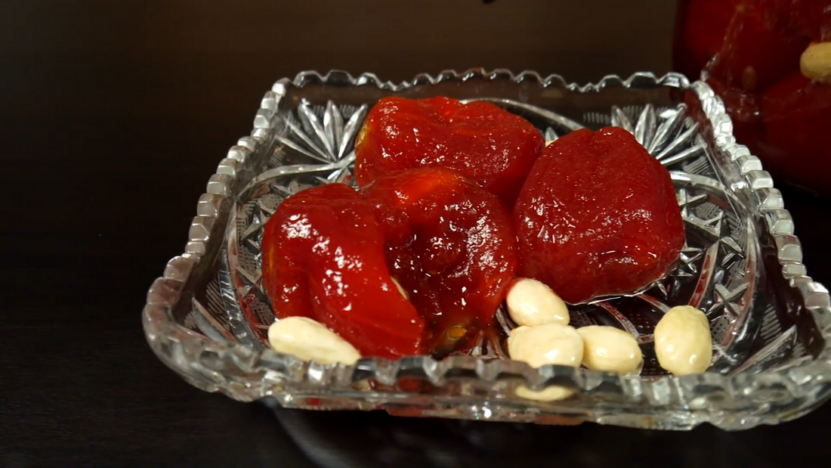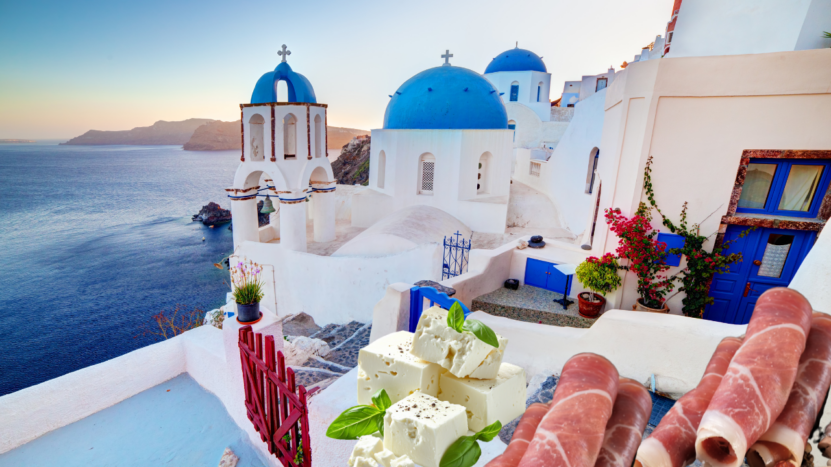Santorini, Greece, is not just famous for its beautiful sunsets and stunning architecture; it is also a paradise for food lovers.
The island’s climate and soil produce exceptional local ingredients that are used to create mouth-watering dishes.
When you visit Santorini, experiencing its food culture is a must.
Wondering what to eat while you’re there?
Let me help you.

10. Ntomataki Glyko (Tomato Spoon Sweet)

Ntomataki Glyko, also known as Tomato Spoon Sweet, is a delightful Greek dessert. Made with cherry tomatoes, this sweet treat combines the tanginess of the tomatoes with the sweetness of syrup.
To make Ntomataki Glyko, cherry tomatoes are boiled in water to remove their skins. The tomatoes are then simmered with sugar, water, and sometimes lemon juice until they achieve a thick, syrupy consistency.
Greek chefs often add a hint of ginger and cardamom to enhance the flavor. This gives the dish a slightly spicy kick that balances well with the sweetness.
Traditionally, Ntomataki Glyko is served on crystal plates with a spoon and a glass of cold water on the side. This not only looks elegant but also complements the dessert’s flavors.
You will often find Ntomataki Glyko in Greek households, especially during special occasions. It’s also served as a gesture of hospitality to guests. Being both unique and delicious, it’s a must-try when you visit Santorini.
9. Moussaka
Moussaka is one of the most iconic dishes you can try in Santorini. It is often compared to lasagna due to its layered structure. There are two major variants of this dish, greek beef and eggplant lasagna.
Traditionally, it includes layers of eggplant, ground beef, and potatoes.
The top layer is bechamel sauce. This adds a creamy and rich flavor that ties everything together. Moussaka is baked until it is golden and bubbly.
In Santorini, some restaurants add their own twist to the classic recipe. Local ingredients, like the island’s sweet tomatoes, can make their way into the dish. This makes the flavors stand out even more.
You can find Moussaka in many tavernas and restaurants across Santorini. It is a dish that represents Greek cuisine well and is widely enjoyed by both locals and tourists. If you are visiting, don’t miss the chance to try it.
Many travelers rate it as one of the best experiences in Santorini. The combination of tender vegetables, savory meat, and creamy topping is unforgettable.
8. Saganaki (Fried Cheese)

Saganaki is a popular Greek appetizer featuring fried cheese. You can find it in many tavernas across Santorini.
This dish is loved for its crispy exterior and gooey, melty center.
The cheese used for Saganaki varies. Common choices include Graviera, a semi-hard cheese with sweet, nutty notes, as well as other local Greek cheeses.
To make Saganaki, chefs coat the cheese in flour and season it with pepper. Next, they pan-fry it in olive oil until golden brown.
Many restaurants serve Saganaki flambéed with a splash of ouzo, ignited at your table for a dramatic touch.
It is best enjoyed hot, drizzled with lemon juice, adding a tangy kick. Saganaki pairs well with fresh bread and is a must-try when in Santorini.
7. Santorini Salad
Santorini Salad is a fresh and vibrant dish perfect for those hot Greek days. It usually features local ingredients like juicy tomatoes, crisp cucumbers, and flavorful olives.
The salad is often topped with tangy feta cheese, adding a creamy texture and rich flavor.
You’ll find the salad enhanced by capers, adding a unique salty touch. The dressing is simple yet effective—usually just olive oil, vinegar, and some dried oregano.
In Santorini, the salad may also include beetroots and pickled onions, which add a bit of zing. The dry climate and mineral-rich soil of the island make the vegetables exceptionally tasty. Each bite is a burst of freshness.
Enjoying a Santorini Salad is a must-do while on the island. It’s a delicious way to taste the unique flavors of Santorini without feeling too full.
6. Chlorotyri (Fresh Goat Cheese)
Chlorotyri, also known as Chloro, is a traditional goat cheese from Santorini. Made from fresh goat’s milk, this cheese is known for its creamy texture and mild taste.
The flavor comes from the special process and the volcanic soil in which the goats graze.
You won’t find Chlorotyri in supermarkets. It’s produced in limited quantities by local artisans on the island. This makes it a rare and cherished treat for visitors.
Look for Chlorotyri in various dishes, especially in the Santorini salad. The cheese pairs well with fresh vegetables, adding a creamy touch to the dish. Trying this cheese is a must when you visit Santorini.
5. Atherina (Fried Whitebait)

Atherina, also known as fried whitebait, is a popular dish in Santorini. These small fish are fresh and locally sourced. They are typically fried to a crispy golden brown.
Before frying, ensure the fish are thoroughly cleaned. Rinse them to remove any sand or seaweed. After cleaning, you let them drain to dry.
When ready to cook, coat the fish lightly in flour mixed with a bit of salt and pepper.
Frying Atherina is quick. The small fish cook evenly, resulting in a crunchy exterior and tender interior. Serve them hot with a squeeze of lemon.
4. Melitinia (Sweet Cheese Pastries)
Melitinia are sweet cheese pastries from Santorini, often seen at weddings, festivals, and other celebrations.
These delightful treats are made with unsalted mizithra, a cheese similar to ricotta, and yogurt.
They are flavored with mastiha, a resin with a slightly pine-like taste.
The dough for melitinia is carefully shaped into tartlet form. Each piece is filled with a spoonful of the sweet cheese mixture and then pinched around the edges.
They are baked until the dough turns a light golden brown and the cheese filling solidifies.
Traditionally, melitinia are made during Easter, but you can find them year-round at many local bakeries. These pastries are small but packed with a rich, creamy flavor.
For an authentic taste, try them at local events or bakeries in Santorini.
3. Apochti (Cured Pork)
Apochti is a traditional Santorini delicacy made from pork. The pork loin is salted, soaked in vinegar, and then rubbed with pepper, savory leaves, and cinnamon.
After seasoning, the meat is hung to dry in a cool place. This process intensifies the flavors and preserves the pork, making it a special treat.
Apochti is typically sliced thin and served with local spirits like ouzo or raki. It’s often enjoyed as an appetizer or a snack.
The combination of herbs and spices gives apochti a complex flavor. When visiting Santorini, trying apochti will give you a true taste of the island’s culinary tradition.
2. Tomatokeftedes (Tomato Fritters)
Tomatokeftedes, or tomato fritters, are a must-try when you visit Santorini. These delicious treats capture the essence of Greek culinary traditions.
They typically feature:
- Ripe tomatoes
- Chopped onions
- Fresh herbs
Sometimes, feta cheese is added for an extra burst of flavor.
To prepare them, mix the ingredients to form a dough. Shape the dough into small patties and fry in olive oil.
The result is a crispy outside with a soft, flavorful inside. Each bite offers a mix of sweet and savory tastes.
You might find variations using cherry tomatoes or regular ones. Both work well, depending on their availability.
The key is to use ripe but firm tomatoes to maintain a good texture. Tomatokeftedes are often served as appetizers, but they can also be enjoyed as a main dish.
Enjoy these fritters with a dip like tzatziki or a squeeze of lemon for a bit of zest. They pair wonderfully with other local dishes and a glass of Santorini wine.
1. Fava (Yellow Split Pea Puree)
Fava is a traditional Greek dish made from yellow split peas. Despite its name, it is not made from fava beans.
The best yellow split peas come from the island of Santorini, where they have been grown for over 3,500 years.
To make Fava, you start by simmering the yellow split peas in water. Be sure to skim off any foam that forms on the surface.
Cook until the peas are soft and mushy. This usually takes up to 45.
Adding flavors like onion, garlic, and bay leaf enhances the taste. Some cooks even add fresh herbs tied in a cotton muslin bag.
Once the peas are mushy, you blend them into a smooth puree. Don’t forget to remove the bay leaf if you used one.
Pouring in a bit of extra virgin olive oil adds richness to the puree. Some recipes also suggest adding a squeeze of lemon juice. Once cooled, Fava is typically served with drizzles of olive oil and lemon wedges on the side.
Fava is a versatile dish, often enjoyed as a dip or a side dish. Its creamy texture and flavorful taste make it a must-try when you’re in Santorini.
The Bottom Line
Eating in Santorini offers a combination of local Greek flavors and modern culinary twists.
Make note of these key spots and dishes when planning your trip, and you’ll be prepared to savor the best of what Santorini has to offer.

